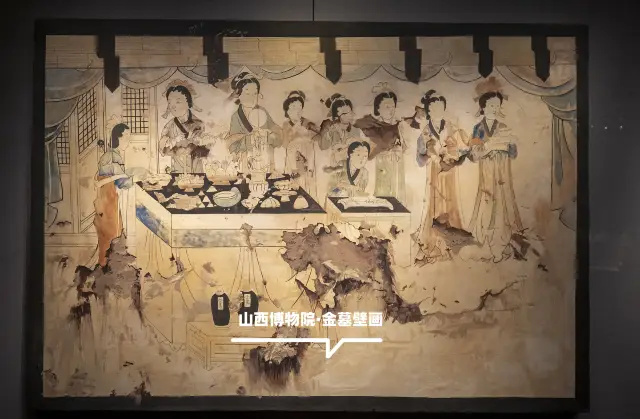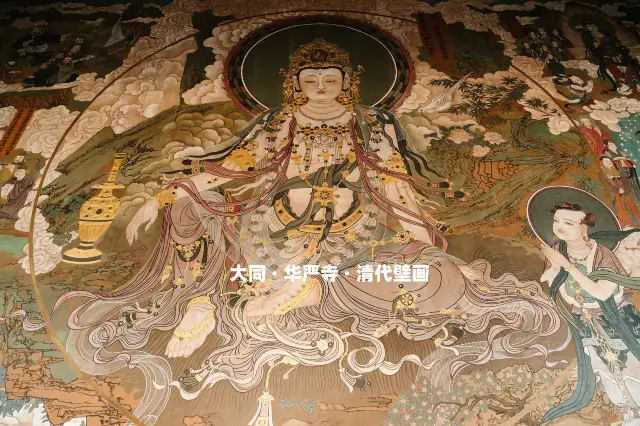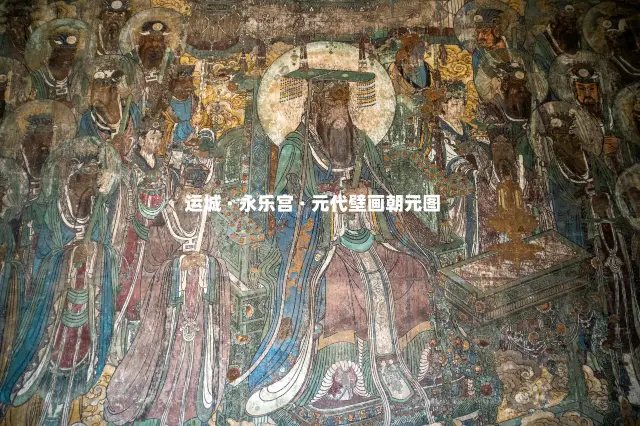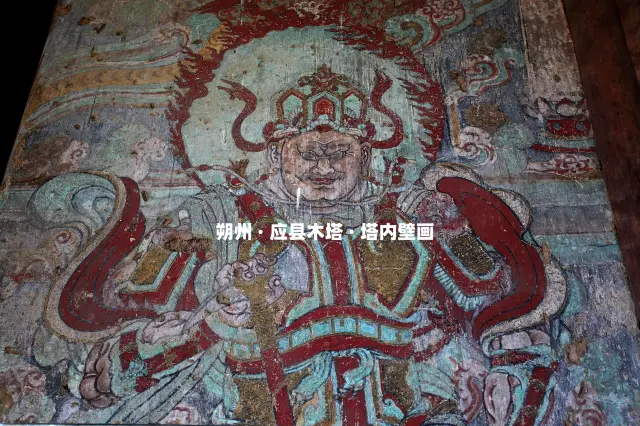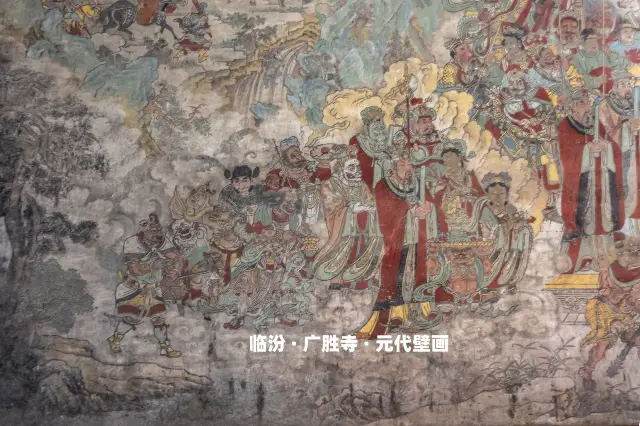Share to
Lvliang
Fenyang
2025Mural Viewing in Shanxi|trip.com
Mural Viewing in Shanxi
6.0
Introduction Mural Viewing in Shanxi
IntroductionSome information may have been translated by Google Translate
Shanxi is one of the regions with the richest ancient murals in China, with murals from the Han Dynasty to the Ming and Qing Dynasties, spanning 2,000 years. Shanxi is one of the provinces with the largest number of ancient murals in the country, and has unique artistic characteristics and value in terms of quality. Visitors can experience the rich mural culture in Shanxi and appreciate the ultimate oriental aesthetics.
Trip Moments Mural Viewing in Shanxi
Mural Viewing in Shanxi Trip Moments

Xinghua Village.
Where is the tavern? The shepherd boy pointed to Xinghua Village. Many people come to Fenyang because of this poem. I originally wanted to go to the Fenjiu Cultural Scenic Area for an industrial tour and visit the Fenjiu factory. However, this attraction is not convenient for individual tourists. I didn't want to wait for people to join the group and waste time, so I went to the Fenjiu Old Workshop Site instead. I feel that the historical atmosphere here is right. If Foshan organizes industrial tours, Jianlibao and Haitian are good choices. First, they are national brands, and second, they can be tasted. They are more interesting and interactive.

An 800-year-old national treasure-level temple, no tickets required but no tourists
In Shanxi, there is actually an 800-year-old national treasure-level temple. No tickets are required but there are no tourists, quietly adding points to Shanxi's cultural tourism! Curious friends might ask, where exactly is this 800-year-old national treasure-level temple in Shanxi that doesn't require tickets but has no tourists? What unknown secrets does it hold? With these questions and curiosity, today we will talk about the Taifu Temple. Taifu Temple is located in Shangmiao Village, Xinghua Town, 17 kilometers northeast of Fenyang City, Lüliang, Shanxi Province. In the fifth year of Jin Cheng'an (1200), a jiao altar was established in the temple, and it was repaired during the Ming and Qing dynasties. The existing Haotian Jade Emperor Hall is an original structure from the Jin Dynasty, while the rest were built during the Ming Dynasty. Taifu Temple faces south, with a length of 177.5 meters from north to south and a width of 50 meters from east to west, covering an area of 8,875 square meters. It has two courtyards, with the central axis running from south to north including a screen wall, a paifang, a reverse stage (the lower level is the mountain gate, with Guan Yu Temple and Erlang Hall on both sides), and the Haotian Jade Emperor Hall (with Houtu Shengmu Hall and Wuyue Hall on both sides). On June 25, 2001, Taifu Temple was announced as the fifth batch of national key cultural relics protection units. A significant cultural relic protection unit, no tickets required but no tourists, quietly adding points to Shanxi's cultural tourism!

Free public transportation! Fenyang, an ancient city with a thousand years of stories!
💥Did you know? The public transportation system in Fenyang is completely free! For those of us who love shopping and exploring, this is such great news! It covers all the scenic spots and the train station within the city, making our visit to this ancient city both easy and economical!💐 🏰Fenyang, a city with a history of over 1700 years as a provincial capital, is truly a treasure trove! Every step you take is on the imprint of history, and every corner hides ancient stories. The Apricot Flower Village Fen Liquor Workshop, Taifu Temple, Wenfeng Pagoda... These historical sites are all worth savoring in detail. ✨Taifu Temple is a particularly low-key place, but once you enter, you will be deeply attracted by its charm. The Ming Dynasty glazed dragons and the colorful suspended clay sculptures are simply treasures of art! Although there are not many tourists usually, this is just perfect, as we can appreciate it quietly, undisturbed.😍 🌸Wenfeng Pagoda is even more a symbolic building of Fenyang. In spring, when the apricot blossoms are in full bloom, they form an interesting contrast with the Wenfeng Pagoda, like a vivid scroll of painting. Standing under the tower, it's as if you can hear the breath of history and feel the passage of time. 🎨There's also the Hou Tu Holy Mother Temple, which may not be very famous, but the Ming Dynasty murals inside are truly unique! The murals on the east, west, and north walls, such as 'Banquet Picture', 'Royal Inspection Picture', and 'Welcoming Picture', are each painted with meticulous brushwork and gold leaf, dazzling to the eyes and eliciting continuous admiration.🙌 🏯Of course, the Bao'en Temple, Christian Church, Fenyang Guandi Temple, and so on in the old streets of Fenyang are also must-visit spots. Especially the Fenyang Nanxun Building, did you know? This was a filming location for the movie 'Mountains May Depart'! Standing here, it feels as if you can experience the emotions and stories from the movie.🎥 💥Overall, the city of Fenyang not only has convenient transportation but also a profound historical heritage and rich cultural relics. Every visit brings new discoveries and new emotions. If you also love history and culture, you must come and see Fenyang!👣
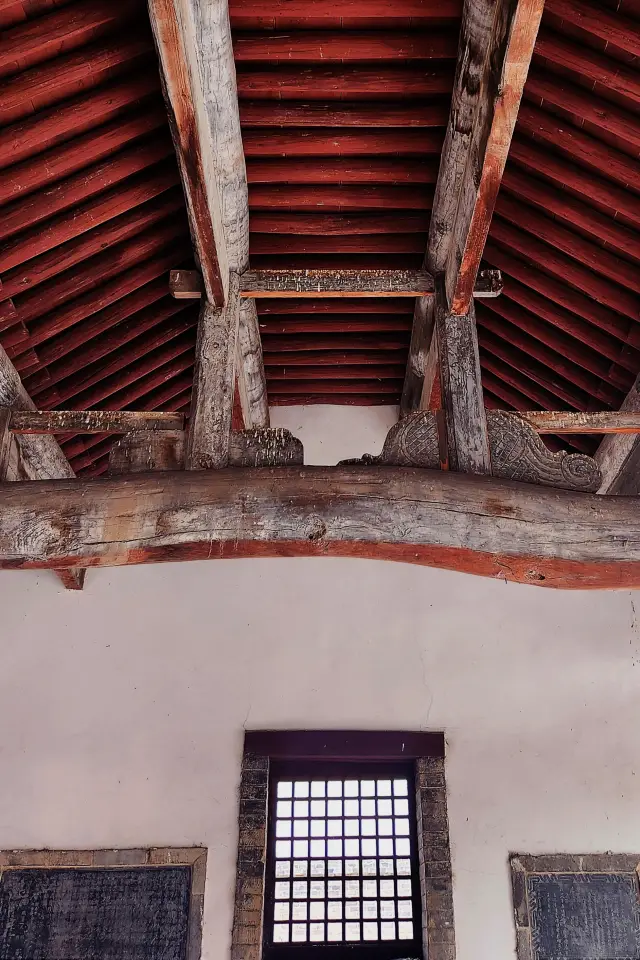
Fall in Love with Baicaopo Tudi Temple, Starting with a Hawthorn
Visiting Baicaopo Tudi Temple was a surprise. After being shut out of Guashan Xuanzhong Temple and Yuko Houtu Temple, I found a Tudi Temple nearby on the map. It is located in Baicaopo Village and is called Baicaopo Longtian Tudi Temple. It is an ancient building from the Yuan Dynasty to the Republic of China. According to online reviews, the cultural relics protection staff is very friendly. The iron gate was locked, so I called the staff, who said he was having lunch and would come after eating. We drove there immediately. When we were near the destination, we heard a dog barking but didn't see any dogs. Looking up, we found the dog on the roof of a house. The door of the house opposite the Tudi Temple was open, so we went in and took a look. We startled an elderly couple, who warmly invited us to sit inside, saying it was too cold outside. They said their dog would bark when the staff came and offered us some washed hawthorns. Although the Tudi Temple is rough, the simple folk customs are like the hawthorns, making me feel the long-lost traditional Chinese rural customs in Shanxi again. How can you not love Shanxi?! After a while, the staff came on a small electric scooter. The Tudi Temple looks new after renovation. From south to north on the central axis, there are mainly a stage, an offering hall, and a Dragon King Hall, with three side halls on the east. The Dragon King Hall was first built in the Jin Dynasty and rebuilt in the Yuan Dynasty, while the others were built in the Qing Dynasty and the Republic of China. The inscription on the beam frame of the main hall of Baicaopo Longtian Tudi Temple records: "Built in the 5th year of the Cheng'an period of the Jin Dynasty (1200), repaired in the 27th year of the Zhizheng period of the Yuan Dynasty (1367)." From south to north on the central axis, there are mainly a stage, an offering hall, and a Dragon King Hall, with three side halls on the east. 📷Highlights: Dragon King Hall: First built in the Jin Dynasty and rebuilt in the Yuan Dynasty, while the others were built in the Qing Dynasty and the Republic of China. Offering Hall: The middle section of the architrave is carved with pavilions, flowers, and other patterns using high and low relief techniques. 📍Address: Baicaopo Village, Yudaohe Town, Fenyang City, Lüliang City 🎫Tickets: Free 🌟National Protection: The 7th batch of national key cultural relics protection units 🎈Opening Difficulty: Easy

The filming location of Black Myth: Wukong is in Shanxi!
Last year, I planned a trip to visit ancient buildings as a designer, and checked in at the following classic ancient buildings in Shanxi: Taiyuan: Jinci Temple, Qingyuan Confucian Temple, Tianlong Temple, Dou Dafu Temple, Shuangta Temple, Chunyang Palace Xinzhou: Drum Tower, Daizhou Confucian Temple, Foguang Temple, Nanchan Temple, Yanqing Temple, Hongfu Temple, Princess Temple, Yanshan Temple Datong: Yungang Grottoes, Huayan Temple, Shanhua Temple, Hanging Temple, Yong'an Temple, Yuanjue Temple Lvliang: Taifu Temple Shuozhou: Yingxian Wooden Pagoda, Chongfu Temple, Jingtusi Temple Jinzhong: Pingyao Ancient City, Houtu Temple, Zishou Temple, Zhenguo Temple, Shuanglin Temple, Jingxin Temple Ruicheng: Yongle Palace The twenty-day journey brought me so much shock. The aesthetics, wisdom, and craftsmanship of the ancients are all worth learning from! However, checking in at ancient buildings in Shanxi is not easy. There are many spots and they are scattered. It is recommended to drive by yourself. Some niche ancient buildings are not open to the public and require contacting cultural preservation personnel.
4

A glimpse into ancient life: The Song and Jin Dynasty tombs of Fenyang
In 2008, during the construction of Xiaofen Avenue, a group of Bagua tombs from the Song and Jin Dynasties was unexpectedly discovered in Fenyang. Archaeologists quickly intervened and took protective excavation measures. However, due to the lack of safety conditions for tourism at the time, the tombs were not opened to the public. In the detailed introduction of the M2 tomb, we learn that the murals inside the tomb are symmetrically arranged along a central axis. On the main wall, the portraits of a couple are prominently displayed. They are framed within a three-bay door, with a large lintel above the door and a curtain hanging from the top, creating a solemn and mysterious atmosphere. Below the couple's portraits, there is a piece of furniture resembling an offering table, making the whole scene both confusing and fascinating. I have always believed that the main wall depicts the family shrine of the tomb owner or their parents, where descendants come to pay their respects during funerals. On either side of the couple's portraits, there are symmetrical patterns of two maidservants holding objects, symbolizing offerings and respect. Next, there are two corresponding door-opening scenes, one entering and one exiting, symbolizing the cycle and flow within the space. The figures in these door-opening scenes are quite large, nearly one meter in height, making them the largest high-relief door-opening scenes I have ever seen in a tomb. Unfortunately, the head of the front figure has been damaged. Finally, the murals in the tomb also depict the exterior of doors and windows, with a small cat carved in relief under the window, adding a lively and interesting touch. It is worth noting that there are no images of guards, such as door officials, but rather a movable tomb door with door nails. The entire tomb seems like a living room leading to another world, full of life and mystery.

Travel Around Shanxi (37) - Luliang · Taifu Temple
Taoism is a native Chinese religion that formed in the 2nd century and has a history of over 1,700 years. Taifu Temple, located in Xinghuacun Town, Fenyang City, Luliang, Shanxi, is a Taoist site with rich content and outstanding architectural wisdom, composed of beautiful painted sculptures, hanging sculptures, and murals. The figures in the hall are three-dimensional and vivid, with meticulous depictions and bright colors. The existing main hall, the Haotian Jade Emperor Hall, is a Jin Dynasty structure, while the rest were built in the Ming Dynasty. Despite the passage of time, the architecture, sculptures, and murals have been well-preserved, retaining their essence and becoming a rare gem among Shanxi's religious architecture. Shanxi is undoubtedly a province rich in cultural relics. The ancients endowed this vast land with the most intelligent ideas, exquisite craftsmanship, unique aesthetics, and brilliant colors. Traveling around Shanxi, you will not only see mountains and rivers but also the wisdom of the ancients, which is forever admired and impossible to replicate. 📌TIPS: 📍Location: Search for Taifu Temple in navigation apps. 💰Tickets: Free 🅿️Parking: There is a free parking lot at the entrance of the scenic area. 🚎Transportation: Five buses go directly to the temple, or you can drive or take a taxi. 🟡️Nearby: Fenjiu Cultural Scenic Area, 7 minutes by car, can be visited in one trip. 🟣️Local delicacies: ✅Fenyang Xuan'er Noodles ✅Jujube with Yellow Rice ✅Fenyang Old Tofu (paired with crispy pancakes, a must-try)

Flowers are blooming everywhere, where should I go to enjoy the flowers first?
🌸 Flowers are blooming everywhere, where should I go to enjoy the flowers first?||| This year's spring indeed arrived a bit late, and flowers all over Changchun have started to bloom one after another. Where can we go to enjoy the flowers in the near future (mid to late April)? Popular spots🔥🔥🔥 🌸 Jilin University Nanling Campus: The Jilin University Apricot Flower Festival will be held on April 21st. This year is the ninth edition, and I haven't been there yet. I heard there will be a series of activities and some stalls, which should be particularly lively. 🌸 Yitong River banks: On the west bank of the Yitong River, starting from Nanhu Avenue Zhihe Square to Satellite Road, there is a flower road lined with peach blossoms (peach trees) that have already started to bloom. Sakura Island is also here, but the flowers on the island will take a few more days. If you follow the road all the way past Satellite Road, you will reach the Industrial Trajectory Park, which is a nice camping site🏕️ 💐 Other flower viewing spots: Changchun Zoo and Botanical Garden Baihuayuan Xinghua Village Park …… 👏 Welcome to add more

Taifu Temple | A mysterious treasure from the depths of time.
| A mysterious treasure from the depths of time. ✨Today, I want to share with you a super niche but absolutely stunning historical site - Taifu Temple. 📍It is located [specific address], far from the hustle and bustle, quietly telling the story of time. When you step into Taifu Temple, it is as if you have traveled back in time to ancient times. The exquisite architecture, with its carved beams and painted rafters, every detail shows the craftsmanship and wisdom of the ancients💯 The statues in the temple are solemn and majestic, and the murals are colorful, and although they have been through the wind and rain, they still retain the charm of the past. Walking in Taifu Temple, you can feel the weight of history, and your soul is deeply baptized. Whether you are a history and culture lover or a traveler looking for peace and unique experiences, Taifu Temple will not disappoint you. Come here and start an unforgettable journey through time! 🌟

Hanging Sculptures and a Five Sacred Mountains Procession | Niche Beauty, Fenyang Taifu Temple
[Shanxi's Beauty: Fenyang, Five Sacred Mountains Procession, Hanging Sculptures] This is a place easily overlooked when traveling in Shanxi. In fact, when we visited, there were almost no other tourists. This is Taifu Temple, located in Xinghua Village, Shanxi's famous Fenjiu production area. The main hall enshrines Haotian Jade Emperor God, also known as the Jade Emperor. The building dates back to the Jin Dynasty, over 800 years ago. The bamboo and wood shrines and small wooden works are exquisite, masterpieces of the Ming Dynasty. However, the most noteworthy feature of Taifu Temple is the Ming Dynasty painted hanging sculptures in the east and west side halls. Over 500 years old, they are still vibrant and lifelike, truly breathtaking! West Side Hall (Five Sacred Mountains Hall): On the upper parts of the two gable walls, there are hanging sculptures depicting the procession of the Five Sacred Mountains and the Four Great Rivers. The design of the sculptures is ingenious and unique. The picture shows continuous mountain peaks and swirling auspicious clouds. The deities of the Five Sacred Mountains and Four Great Rivers ride in dragon carriages, palanquins, or on horseback, attended by servants holding umbrellas and fans, moving between the mountains, clouds, and mist. Tigers and leopards roam the forests, a green dragon conjures rain among the auspicious clouds, and figures like mountain ghosts and judges, each with their own unique expressions. The figures, animals, clouds, and rocks in the entire scene blend seamlessly, complementing each other, dynamic in stillness, still in motion, combining reality and illusion, vividly depicted, with diverse forms and rich variations. East Side Hall (Houtu Holy Mother Hall): Five rooms wide, seven purlins deep, with a four-pillar front porch structure and a single-eave suspension roof. Inside the hall, 35 painted sculptures are enshrined on the altar and the lower parts of the two gable walls. The back wall and the two gable walls are painted with murals of "Banquet Scenes," depicting life in the Holy Mother's palace. The gable walls are covered with hanging sculptures, showcasing scenes of the Holy Mother's "departure" and "return." Tips: Taifu Temple closes for lunch at 11:30 am and reopens at 3:00 pm.

A Glimpse into the Daily Life of the Wealthy from a Millennium Ago
Tomb M5 in the Fenyang Song-Jin Tombs is the tomb of Wang Li. Wang Li was a prominent landowner in the area during the Mingchang period of the Jin Dynasty (1195), and his name is also mentioned in the "Record of the Construction of the Jiaotan Altar at Taifu Temple" from the Cheng'an period of the Jin Dynasty (1200). The murals in Tomb M5 are rich and diverse. The "Incense Kitchen" and "Tea and Wine Area" murals are located on the northwest and northeast walls of the tomb, respectively. The tomb features numerous figures, including the elderly tomb owner and his wife, boys, girls, beautiful singing girls, honest male servants, fierce-looking door gods, and meticulous accountants. These figures have different identities, rich facial expressions, and diverse clothing. In the "Tea and Wine Area" mural, the tea-making scene is particularly striking. The depiction of tea making is unique, highlighting the specific actions of whisking the tea to a boil and frothing it. The male servants on either side of the tomb door in Tomb M5 hold different items: the servant on the east side holds a fan in his left hand, while the servant on the west side carries a money bag on his left shoulder. They face the tomb owner, reflecting the family workshop-style commercial economy of the time. The "Woman Opening the Door" motif in Tomb M5 is a common pattern found on tombs and pagodas since the Han Dynasty. The woman depicted in Tomb M5 is young and beautiful, half-concealed behind the door, as if about to emerge. This aligns with the custom of wealthy families in the Song-Jin period keeping female entertainers and singers. The money exchange scene and the early form of a bank depicted in Tomb M5 are among the most significant discoveries of this excavation. This mural, located in a prominent position within the tomb, features three figures: one woman and two men. Inside a fenced area, a man stands at a window, holding a small slip of paper and conversing with someone outside. Outside the fence, to the left, a man sits at a wooden table, writing. To the right of the wooden table, opposite the man, a woman walks forward, holding a string of copper coins. This scene provides valuable clues about the form of banks and the money exchange process during that time.

The shepherd boy points to the Apricot Blossom Village from afar
The most beautiful apricot blossom forest in Shanxi is all in Apricot Blossom Village. 📢The sixth Fenjiu Apricot Blossom Festival has opened in the Fenjiu Cultural Scenic Area. Fenjiu is a must-drink for all major events. I've been here several times and really love the aroma of the liquor in the air. This time, it's not just about sharing the fun, but also teaching everyone how to have fun here, without missing out on the culture and experience. Route: Tourist Center (buy tickets) ➡️ Take the electric car to Fenjiu Museum ➡️ Drunken Immortal Residence Shepherd Boy Points to Apricot Blossom Village ➡️ Fenjiu Cultural Scenic Area Apricot Forest ➡️ Fenjiu Cultural Scenic Area Drunken Immortal Tower ➡️ Fenjiu Cultural Scenic Area China Fenjiu Calligraphy and Painting Academy ➡️ Fenjiu Cultural Scenic Area Drunken Immortal Lake Fenjiu Museum: Here you can find the origin of brewing, the earliest brewing utensils (cultural relics), and the earliest form of Fenjiu. Fenjiu participated in the international brewing competition for the first time, and there are also ink treasures written by literati and poets. The most famous is that the Fenjiu Museum has works by four Aixinjueluo painters and calligraphers. I have previously introduced Qigong, Pu Jie, and Shaman Weng in detail. The fourth is Jin Yian. You can also watch the ancient brewing process of Fenjiu up close, as well as taste Baiyu Fenjiu, Rose Fenjiu, Bamboo Leaf Green, and Fenjiu. After leaving the museum and arriving at the Drunken Immortal Residence, you can see the most famous sculpture of the shepherd boy pointing to the Apricot Blossom Village, and you can also see the ancient well where Fenjiu was first brewed, as well as well water. The Fenjiu Apricot Blossom Festival also has performances. 🌸Next, it's time to take a lot of beautiful photos. Once you arrive at the Fenjiu Cultural Scenic Area, it includes all the remaining attractions on my route map. This is a large park with apricot forests, lakes, grasslands, academies, and ancient buildings. The wind blows gently, and a rain of apricot blossoms falls, how romantic. 📷Photo spots: There are apricot forests here, you can step on the grass or sit on the grass, you can also take photos here with the kite, or in the pink scene set up here, walk and shoot all the way. 👗Outfit suggestions: You can wear pink clothes, full of spring atmosphere, or choose green tones, full of forest style, light-colored clothes can give a high-end magazine feel in minutes.👘 You can also transform into a Hanfu little sister, holding an oil-paper umbrella and walking in the apricot blossom rain, you are the heroine of the costume drama. 📍Location: Northwest 350 meters from the intersection of Taibai Road and Jiudu Avenue, Apricot Blossom Village Town, Fenyang City, Lvliang City, Shanxi Province Ticket: 60 🚗Driving: It takes about 1 hour to drive from Taiyuan on the highway
More Recommendations
More Recommendations
Popular Types of Attractions in Fenyang
Historical attractions | Nature and wildlife | Natural scenery | Mountain climbing | Beaches and shores | Sightseeing tours | Night view | Boat tour | Cultural institutions | Museums | Themed exhibition halls | Science & technology museums | Parks | Amusement parks | Ice and snow parks | Film and television bases | Outdoor activities | Exhibitions & events | Performances | Exhibitions | Concerts | Leisure activities | Farms and pastures | Camping and campsites | Spa/massage | Skybound experiences
Popular Restaurants in Fenyang
汾州老味道 | 酒都宾馆对外餐厅(杏花店) | Jiudoubinguanhuoguolou | 德克士(汾阳筱雅店) | CHEN GU JIU LOU | 孙二娘火锅(杏花店) | 田三农庄饺子馆(永和东大街店) | 德克士(汾阳广通店) | CHEN GU JIU LOU | 六厂烤肉 | 汾胖功夫猫耳朵 | 小相村茂盛酒楼 | Shanheguren | 绝味鸭脖(吕梁店) | 汾阳隐南小院 | 百姓食府(学院路店) | 品译中西餐厅(汾阳店) | 海清鸡公煲(汾阳店) | 不老泉酒店(英雄北路店) | 香蜜园蛋糕 | 心岸(雍和店) | 心岸(鼓楼店) | CHEN GU JIU LOU | LI XIAN SHENG AN TONG DA SHA DIAN | BEI GUAN KOU CHUAN CHUAN XIANG | 巴蜀老大纸包鱼(文峰路店) | 缘味先石锅饭(府学街店) | 巴蜀老大纸包鱼(东一环店) | 伍姑娘的店 | 重庆小天鹅火锅(汾阳店)
Popular Destinations
Canela Travel | Cascade Travel | Tunis Travel | Curry County Travel | Split Travel | Smith County Travel | Savoie Travel | Prospect Travel | Thibodaux Travel | Carroll County Travel | Baja Sardinia Travel | Boulogne-sur-Mer Travel | Sheffield Travel | Charlevoix Regional County Municipality Travel | Messina Travel | Buffalo County Travel | Baraboo Travel | Landskrona Travel | Limestone County Travel | Lewisboro Travel | Lubbock County Travel | Eisenstadt Travel | Bologna Travel | Ela Township Travel | San Giovanni Rotondo Travel | Russellville Travel | Tomioka Travel | State College Travel | South Point Travel
Recommended attractions at popular destinations
Popular Attractions in Bangkok | Popular Attractions in Manila | Popular Attractions in Tokyo | Popular Attractions in Taipei | Popular Attractions in Hong Kong | Popular Attractions in Seoul | Popular Attractions in Kuala Lumpur | Popular Attractions in Los Angeles | Popular Attractions in Shanghai | Popular Attractions in New York | Popular Attractions in Shenzhen | Popular Attractions in Osaka | Popular Attractions in Singapore | Popular Attractions in London | Popular Attractions in Guangzhou | Popular Attractions in San Francisco | Popular Attractions in Beijing | Popular Attractions in Macau | Popular Attractions in Bali | Popular Attractions in Jakarta | Popular Attractions in Paris | Popular Attractions in Ho Chi Minh City | Popular Attractions in Istanbul | Popular Attractions in Phuket | Popular Attractions in Chicago | Popular Attractions in Seattle | Popular Attractions in Toronto | Popular Attractions in Orlando | Popular Attractions in Cebu | Popular Attractions in Chiang Mai
Popular Ranked Lists
Popular Luxury Hotels in Onna | Top 20 Luxury Hotels in Kyoto | Top 50 Must-Visit Restaurants in Osaka | Top 50 Must-Visit Restaurants in Seoul | Popular Luxury Hotels in Southbank | Top 50 Must-Visit Restaurants in Melaka | Top 50 Must-Visit Restaurants in Busan | Top 50 Must-Visit Restaurants in Phuket | Top 50 Must-Visit Restaurants in Taipei | Top 20 Best Things to Do in Santorini | Popular Luxury Hotels in Surfers Paradise | Top 20 Best Things to Do in Nagoya | Popular Luxury Hotels in Nanjo | Popular Best Things to Do in Boracay Island | Top 10 Luxury Hotels in Chiang Mai Province | Top 10 Local Restaurants in Lushan Global Geopark | Top 50 Must-Visit Restaurants in Santorini | Top 50 Best Things to Do in Saint Petersburg | Popular Luxury Hotels in Millers Point | Top 20 Best Things to Do in Geneva | Top 50 Must-Visit Restaurants in Guam | Popular Luxury Hotels in Al Dhafra | Top 10 Luxury Hotels in Siem Reap | Top 10 Luxury Hotels in Kedah | Top 50 Must-Visit Restaurants in Macau | Top 50 Best Things to Do in Barcelona | Top 50 Best Things to Do in Madrid | Top 50 Best Things to Do in Moscow | Top 10 Luxury Hotels in Ho Chi Minh City | Top 50 Best Things to Do in Seogwipo
Popular Trip Moments
Fenyang Donglongguan Visiting Guide, the Ceiling of the Song-Jin Tombs | A One-Day Itinerary Sharing in Fenyang | Tomb M5 of Donglong Temple, he actually has two wives | Taifu Temple | Ningbo in autumn and winter is like a huge palette!!! Live update on 11.23 | Shanxi's Lesser-Known National Treasure! The Most Underrated 800-Year-Old Unique Hanging Sculpture | Roaming Fenyang: Visiting Jia Zhangke's Film Locations and Nationally Protected Ancient Buildings | By the apricot blossom village, encounter Taifu Temple: a cup of Fenjiu, a hall full of immortals and Buddhas | Tai Fu Temple in Fenyang: A Visual Feast of Jin Dynasty Ancient Temple and Ming Dynasty Hanging Sculptures | Shanxi Fenyang Houtu Shengmu Temple: A Visual Feast of Ming Dynasty Murals | Lanzhou Ink Wash Danxia|Step into the Fairy Tale Oil Painting World of Autumn | Fenyang Taifu Temple|Unlock a Millennium-Old Temple for Free | Head to Taiyuan for a musical rendezvous with Dao Lang, plus a super comprehensive travel guide | Discovered a treasure trove of wine culture at Xinghua Village Hotel, let's experience it together! | Shanxi Summer Food & Travel Vlog | Shanxi Lüliang | May-June Off-Season is Truly Amazing with Fewer Crowds and Beautiful Scenery | Memories of the War of Resistance and Revolutionary Glory on the Red Soil of Lüliang Heroes | 9 must-see attractions in Luliang | 【Lvliang Travel Guide: A Hard-core Happy Guide to the Loess Plateau | Famous Village Attraction in Fenyang City, Lüliang, Shanxi Province: Xinghua Village Temple | Hanging Sculptures and a Five Sacred Mountains Procession | Niche Beauty, Fenyang Taifu Temple | A Glimpse into the Daily Life of the Wealthy from a Millennium Ago | A glimpse into ancient life: The Song and Jin Dynasty tombs of Fenyang | Travel Around Shanxi (37) - Luliang · Taifu Temple | Fall in Love with Baicaopo Tudi Temple, Starting with a Hawthorn | The Painted Sculptures of Fenyang Taifu Temple: The Fairies of Fenyang | Taifu Temple | A mysterious treasure from the depths of time. | Xinghua Village. | An 800-year-old national treasure-level temple, no tickets required but no tourists | The filming location of Black Myth: Wukong is in Shanxi!
More Things To Do in Fenyang
Luliang Travel Photography[Driver and director + makeup and clothing + itinerary customization + aerial micro-film + free negatives + no limit on the number of people] | Lvliang Jiaocheng multilingual guide services, private charter, customized travel planning, business accompaniment, and professional photography documentation. | Fenyang Trip Moments[Taifu Temple/Wenfeng Tower photography services including aerial, appointment, companion, wedding, and portrait photography with multilingual translation and local photographer guides] | Mainland China 5G eSIM | Day Pass/Total Data Package | ChatGPT Available | 24-Hour Billing | 1-30 Days | QR Code | Mainland China | 5G/4G eSIM | Supports TikTok & ChatGPT (Partial Only) | Day Pass/Total Package | 24H Billing | 1–30 Days | QR code | Mainland China/Hong Kong/Macau 5G eSIM | Daily Package/Total Data Package | 24-Hour Billing | 1-30 Days | QR Code | Global (66 countries) | 4G/5G eSIM | Total Package | 1-7 days | 24H Billing | Real-Name Auth Required (Hong Kong & Taiwan) | QR code | Mainland China/Hong Kong/Macao/Taiwan | 5G eSIM | Day Pass/Total Package | 24H | 1-30 days | QR code | Mainland China · Hong Kong · Macau 5G eSIM | Full AI & TikTok Access | 1–30 Days / 365 Days | Instant QR | Asia 9 Destinations 5G eSIM | Japan, Thailand, Vietnam, Indonesia, Korea & More | 1–30 Days | Instant QR | China eSIM | 5G/4G | Daily package/Data package | High-speed data | Natural day | 1-30 days | QR code | Mainland China 5G eSIM | ChatGPT & TikTok | 1–30 Days / 365 Days | Instant QR | Asia 8 countries 5G/4G eSIM | DayPass/Total | 1-30 days | QR code | Global 77 Countries 4G/5G eSIM | TikTok & ChatGPT Available | Day Pass/Total Data Package | 24-Hour Billing | 1-30 Days | QR Code | China Mainland 5G/4G eSIM | DayPass / Total | 500MB/day - Total 30GB | 1-30 Days | 24-Hour Billing | QR Code | Jinzhong Yushe multilingual guide services, private charter, customized travel planning, business accompaniment, and professional photography documentation. | China Mainland, Hong Kong&Macau eSIM | DayPass /Total | 500MB/day-total 30GB | 1-30 days | QR code | Trip Moments in Pingyao Ancient City, Jinzhong[Jinyao Ancient Style Photo Studio (Multi-Dynasty Costume Selection + Classical Makeup Experience + Optional Photography Session)] | Jinzhong Travel Photography[Wedding photo micro-movie aerial photography/wedding follow-up photography/makeup and clothing/charter tour guide customization] | Taiyuan Travel Photography[Wedding photo micro-movie aerial photography/wedding follow-up photography/makeup and clothing/charter tour guide customization] | Half-Day Private Walking Tour of Pingyao Ancient City | Trip Moments in Fangshan[Nansongyan/Qingjiang Fangshan photographer guide with car, travel companion, aerial photography, portrait photography, and photo shoot services] | China (Mainland and Macau) 5G/4G eSIM|China Unicom official product | [China, Hong Kong and Macau] 4G network | Unlimited traffic | Self-pickup at the airport | WiFi rental, high-speed traffic, shared by multiple people, ready to use at startup, 12H standby, 24H customer service | Yaliaojia Greater China Card | Mainland China/Hong Kong/Macau/Taiwan | Phone number included | App registration available|Receive SMS|365 days | No real-name required for inland use | Mainland China | 5G eSIM | Some plans include voice calls | Some plans support TikTok & ChatGPT | Daily/All-inclusive packages | 1-365 days | Calendar days | QR Code | Global 108 Destinations 5G eSIM | One eSIM, Worldwide Coverage | 1–30 Days | Instant QR | [China Mainland] eSIM | SIM to China | 8GB 8days 4G high speed | Taiyuan Travel Photography[Driver and director + makeup and clothing + itinerary customization + aerial micro-film + free negatives + no limit on the number of people] | Taiyuan Travel Photography[Driver and director + travel photography + aerial photography of wedding photos and micro-film + makeup and Clothes & Accessories+ itinerary customization + free negatives]
